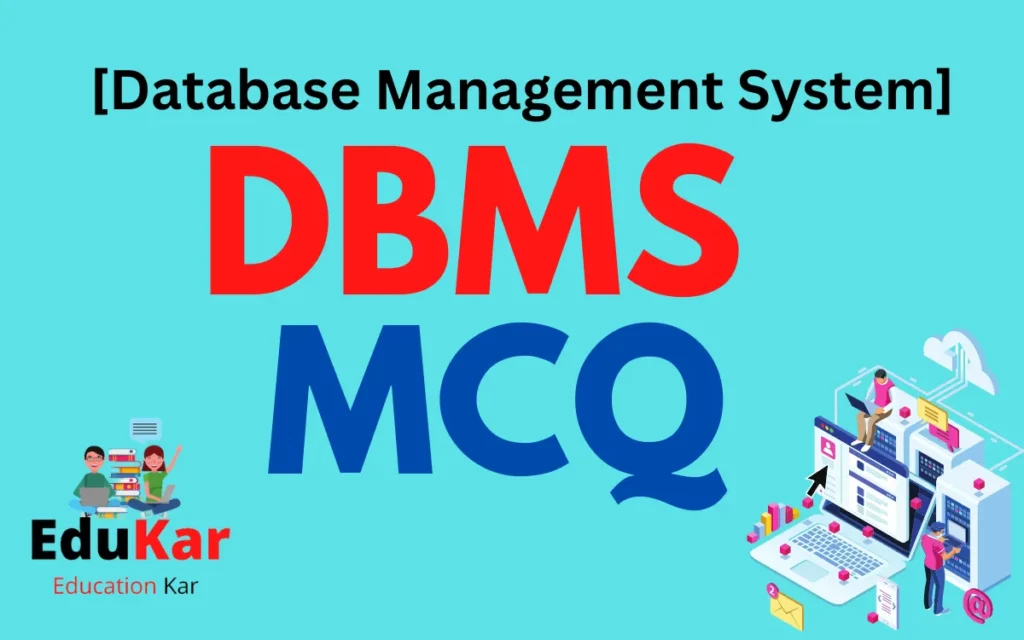A database management system is a system that contains all the tools to manage a database. It provides tools to organize and maintain a database, and to get data into and out of that database. They are typically used to store, organize, and access data in a database, but they can also be used to manage other pieces of software. Different database management systems are used for specific purposes. In general, database management systems are used for storing and managing large amounts of data. These systems may also be used for the management of data in relational data bases, and for the manipulation of the data in such data bases.

MCQ on DBMS (Database Management System)
1) Which of the following is typically employed for duties like building the relations’ organisational structure and deleting relations?
- DML(Data Manipulation Language)
- Query
- Relational Schema
- DDL(Data Definition Language)
Answer: (4) DDL(Data Definition Language)
2) Which of these fixed roles may we utilise to add or remove user IDs?
a. db_setupadmin
b. db_securityadmin
c. db_accessadmin
d. db_sysadmin
Answer: (c) db_accessadmin
3) How do you define one-to-many relationships?
- One class may have many teachers
- One teacher can have many classes
- Many classes may have many teachers
- Many teachers may have many classes
Answer: (2) One teacher can have many classes
4) Which of the following allows you to insert, remove, and alter tuples in the database as well as query information from it?
- DML(Data Manipulation Language)
- DDL(Data Definition Language)
- Query
- Relational Schema
Answer: (1) DML(Data Manipulation Language)
5. How do we substitute another sign for the except?
a. ~
b. ¬
c. V
d. ^
Answer: (b) ¬
6. What other term would you use to describe a weak entity?
a. Dominant
b. Owner
c. Child
d. All of the above
Answer: (c) Child
7. Assume that relation X (M, N, O, P, Q) has the functional dependencies shown below:
MNO -> PQ and
P -> MN
There would be the following total superkeys for X:
a. 12
b. 10
c. 7
d. 2
Answer: (b) 10
8. Fifth Regular form is focused on:
a. Join dependency
b. Domain-key
c. Multivalued dependency
d. Functional dependency
Answer: (a) Join dependency
9. A password is not necessary for the ____ system to access the internet.
a. Response
b. Challenge-response
c. Manipulation
d. Readable
Answer: (b) Challenge-response
10. A log switch can be compelled by employing:
a. ALTER SYS LOG FILES
b. ALTER SYSTEM SWITCH LOGS
c. ALTER SYSTEM LOG
d. ALTER SYSTEM SWITCH LOGFILE
Answer: (d) ALTER SYSTEM SWITCH LOGFILE
11. When bouncing back from a failure:
a. Each pair of physical bricks is examined.
b. A specific pair of physical blocks are examined.
c. The initial physical block pair is examined.
d. none of the above
Answer: (a) Each pair of physical bricks is examined.
12. Utilising optical disk technology are:
a. RAID
b. A laser beam
c. DAT
d. Helical scanning
Answer: (a) RAID
13. In a B+ tree, the node that points in the direction of another node is called:
a. External node
b. Leaf node
c. Internal node
d. Final node
Answer: (c) Internal node
14) The term”________” refers to a substantial accumulation of information or data gathered from numerous sources.
- Data Management
- Data Mining
- Data Warehouse
- Both B and C
Answer: (3) Data Warehouse
15) Which of the following techniques can be applied to extract or filter data and information from the data warehouse?
- Data redundancy
- Data recovery tool
- Data mining
- Both B and C
Answer: (3) Data mining
16) Which of the following describes duplicates of the same data (or information) taking up memory space in different locations?
- Data Repository
- Data Inconsistency
- Data Mining
- Data Redundancy
Answer: (4) Data Redundancy
17. The protocol locking in crab runs like follows:
a. down the tree, back up
b. up the tree, back down
c. down the tree, releases
d. up the tree, releases
Answer: (a) down the tree, back up
18. The first commercially available microprocessor chip had the following name:
a. Intel 4004
b. Intel 639
c. Intel 308
d. Motorola 33
Answer: (a) Intel 4004
19. The simplest approach for us to change control is when the old primary transmits _________ to the old backup site.
a. Redo logs
b. Primary Logs
c. Undo Logs
d. All of the above
Answer: (b) Primary Logs
20. The complexity of a linear search algorithm would be:
a. O(n2)
b. O(n log n)
c. O(n)
d. O(log n)
Answer: (c) O(n)
21) The phrase “Data” describes:
- Information is represented electronically ( or data)
- Basic information
- Row Facts and figures
- Both A and C
Answer: (3) Row Facts and figures
22) The ______ of a connection refers to its rows.
- Degree
- Tuples
- Entity
- All of the above
Answer: (4) All of the above
23) Which of the following phrases describes how many tuples there are in a relation?
- Entity
- Column
- Cardinality
- None of the above
Answer: (3) Cardinality
24) Which of the following is a sort of command for data manipulation?
- Create
- Alter
- Delete
- All of the above
Answer: (3) Delete
25) Which of the aforementioned instructions falls under the category of Data Definition language commands?
- Create
- Update
- Delete
- Merge
Answer: (1) Create
26) Which of the following describes a top-down strategy where the higher level of the entity can be split into two lower sub-entities?
- Aggregation
- Generalisation
- Specialization
- All of the above
Answer: (3) Specialization
27) Which of the following best describes how various lesser entities are gathered (or integrated) into one higher-level entity?
- Specialization
- Generalization
- Aggregation
- None of the above
Answer: (2) Generalization
28) Every tuple that has been partitioned into fields in a relational database is referred to as the_____.
- Queries
- Domains
- Relations
- All of the above
Answer: (2) Domains
29) TCL is an acronym for
- Ternary Control Language
- Transmission Control Language
- Transaction Central Language
- Transaction Control Language
Answer: (4) Transaction Control Language
30) Which of the following can also be referred to as a “attribute” in a relational table?
- Entity
- Row
- Column
- Both B &C
Answer: (3) Column
31) Which of the following describes how many attributes there are in a relation?
- Degree
- Row
- Column
- All of the above
Answer: (1) Degree
32) Which of the following is utilized by application applications to ask the database management system for information?
- Data Manipulation language
- Data Definition Language
- Data Control Language
- All of the above
Answer: (1) Data Manipulation language
33) Which of the subsequent commands should you use to delete an existing row from a table?
- Delete
- Update
- Insert
- None of the above
Answer: (1) Delete
34) Which of the subsequent instructions is used to permanently store any transaction into the database?
- Commit
- Rollback
- Savepoint
- None of the above
Answer: (1) Commit
35) What command is used to remove (or delete) a relation from the SQL database?
- Delete
- Drop
- Remove
- All of the above
Answer: (2) Drop
36) Which of the subsequent commands is used to return the database to the condition it was in just before it was committed?
- Savepoint
- Rollback
- Commit
- Both A & B
Answer: (2) Rollback
37) When it comes to creating and maintaining databases, the database management system may be thought of as a collection of .
- Translators
- Programs
- Keys
- Language activity
Answer: (2) Programs
38) What does the phrase “DFD” mean?
- Data file diagram
- Data flow document
- Data flow diagram
- None of the above
Answer: (3) Data flow diagram
39) Which of the following describes the gathering of data that is kept in a database at a particular time?
- Independence
- Instance of the database
- Schema
- Data domain
Answer: (2) Instance of the database
40) SQL is the acronym for
- Standard query language
- Sequential query language
- Structured query language
- Server-side query language
Answer: (3) Structured query language
41) Data independence is referred to as…
- Programs do not contain any of the defined data.
- The logical characteristics of the data are independent of programs.
- Programs are independent of the data’s physical characteristics.
- Both B & C
Answer: (4) Both B & C
42) How does relation calculus work?
- It is a kind of procedural language
- It is a non-procedural language
- It is a high-level language
- It is Data Definition language
Answer: (2) It is a non-procedural language
43) Which of the following describes the entire database’s content?
- Conceptual view
- Physical view
- Internal view
- External view
Answer: (1) Conceptual view
44) What function does the DML serve?
- Addition of new structure in the database
- Manipulation & processing of the database
- Define the physical components of the database system.
- All of the above
Answer: (2) Manipulation & processing of the database
45) A database’s architecture can be thought of as the .
- Oral database connectivity
- Oracle database connectivity
- Open database connectivity
- Object database connectivity
Answer: (3) Open database connectivity
46) In the relation model, the relations are frequently referred to as ______________.
- One level
- Two-level
- Three-level
- Four level
Answer: (3) Three-level
47) The relations are typically referred to as ___________ in the relation model.
- Tuples
- Attributes
- Rows
- Tables
Answer: (4) Tables
48) The general purpose of the Database Management Query language is the __________.
- Support end-users who use English like commands
- Specifying the structure of the database
- Support with the creation of sophisticated software applications
- All of the above
Answer: (4) All of the above
49) Which of the following keys represents the connections between the tables most frequently?
- Primary key
- Foreign key
- Secondary key
- None of the above
Answer: (2) Foreign key
50) Which level among the following is regarded as being closed to end users?
- Internal Level
- External Level
- Conceptual Level
- Physical Level
Answer: (2) External Level

![[MCQ] Introduction to Computer Online Test introduction-to-computer-mcq-online-test](https://edukar.in/wp-content/uploads/2022/09/Introduction-to-Computer-MCQ-Online-Test-1024x536.webp)


![Java MCQ with Answers [2023] Java MCQ with Answers](https://edukar.in/wp-content/uploads/2022/12/Java-MCQ-1024x640.webp)


